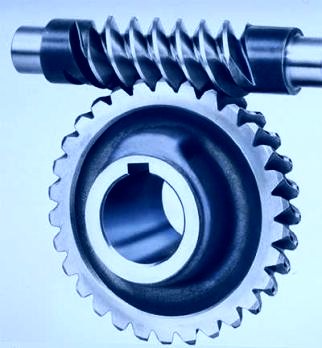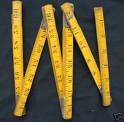
Peristaltic movement occurs in pipes in which something is transported like in a peristaltic pump or in the digestive tract. This seems to be the normal configuration as the word comes from Greek words describing "to wrap around" and "to place".
The complementary configuration is an object (or subject) that carries out peristaltic movements to move itself over the ground or in the ground in the way the earthworm fig 1 does.
 |
To demonstrate of peristalsis a most simple model will be built. A worm gear fig 2 where a screw turns connected to a gear is rather close to the principle and also by name. Just its construction relies on several bearings so a more direct approach is preferred.
To make the model simple, the form of the earthworm is reduced to two dimensions. The stretched out worm has angular symmetry to its axis. For the Model it is reduced to the thickness and the length.
The resulting function can be compared with a folding rule which is like in fig 3 folded in an zigzag configuration where the hinges are alternately at the top and at the bottom. The length of the elements represent the length of the skin which stays constant in length but changes its form.
In the model the lower hinges of the folding rule are connected to parallel horizontal rails. There are 3 rails in the simple model. The first lower hinge is connected to the first rail, the second to the second rail and the third to the third. Then with the fourth hinge the period starts again with the first rail. With all rails moved forth and back in a sinus function over time and with an equal phase difference of 120° between them, configurations according to fig 4 will come up.
The upper hinges show an almost circular movement, all into the same direction, right or left according to the phase difference of 120° or -120°.
When the circular movement goes to the left (or positive) direction, all the upper hinges which are in a relatively high position move to the left and those of the upper hinges which are in a relatively low position move back to the right. A flat object that is put onto the top of the upper hinges is then transported to the left.
 |
 |
 |
In fig 5 a mechanical model for peristalsis is shown. Three rails are driven by a crankshaft and connection rods to provide the 120° phase shift. Turning the crank to the right or to the left provides the +120° or -120° phase shift between the rails that result in a left or right movement of an object placed on top of the peristaltic arcs.
In this case the skin is not carried out in form of a folding rod but made out of red plasic sheet that bends to different height according to the spacing between the lower fixing points.
In that way it also comes back closer to the earthworm from which the idea for the model has come.
 |